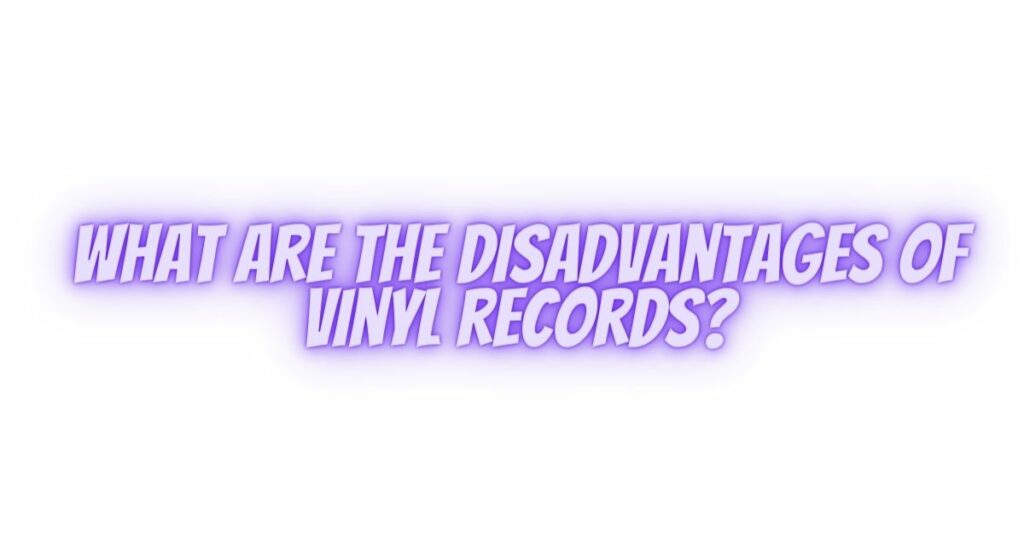Vinyl records have experienced a remarkable resurgence in popularity over recent years, drawing in audiophiles, collectors, and music enthusiasts. While vinyl records offer a unique and nostalgic listening experience, it is important to acknowledge their disadvantages. In this comprehensive article, we will explore the drawbacks and challenges associated with vinyl records in the digital age.
1. Susceptibility to Damage:
One of the most significant disadvantages of vinyl records is their fragility. They are susceptible to various forms of damage, including:
- Scratches: Even minor scratches on the surface of a vinyl record can produce audible pops and clicks during playback, detracting from the listening experience.
- Warping: Exposure to heat or pressure can cause vinyl records to warp, resulting in uneven playback and potential skipping.
- Dust and Debris: Dust particles and debris can accumulate on the record’s surface, leading to surface noise and degradation in sound quality.
2. Limited Playback Time:
Vinyl records have physical constraints that limit the amount of audio that can be stored on each side. Longer albums or tracks may necessitate multiple discs, interrupting the listening experience and requiring manual flipping of the record.
3. Background Noise:
While some vinyl enthusiasts appreciate the warm, analog sound of vinyl records, others find the inherent background noise, including hiss and pops, distracting. Surface noise is an inherent part of vinyl playback, which can diminish the clarity and purity of the music.
4. Inconsistent Sound Quality:
The quality of vinyl records can vary significantly based on several factors, including the pressing quality, vinyl material, and the mastering process. Inconsistencies in sound quality can be frustrating for audiophiles seeking the highest fidelity.
5. Limited Portability:
Vinyl records are relatively large and heavy compared to digital formats, making them less portable. They are not well-suited for on-the-go listening, and the need for a turntable and playback equipment limits their mobility.
6. Maintenance Requirements:
Proper maintenance is essential to keep vinyl records in optimal condition. Regular cleaning and care are necessary to prevent dust and debris from accumulating and to minimize wear on the stylus (needle).
7. Cost and Accessibility:
Building a high-quality vinyl setup, including a turntable and audio equipment, can be costly. Additionally, new vinyl releases and limited editions can carry higher price tags compared to digital downloads or streaming subscriptions. The availability of specific albums on vinyl may also be limited.
8. Limited Availability:
While the vinyl revival has led to increased production, not all music is available on vinyl. Some artists and genres may have limited vinyl releases, limiting choices for vinyl enthusiasts.
9. Analog Format Limitations:
Vinyl is an analog format, which means it lacks the convenience of digital features like skipping tracks, creating playlists, or accessing extensive metadata and album information that digital formats offer.
10. Environmental Concerns:
The production of vinyl records involves the use of polyvinyl chloride (PVC), which raises environmental concerns due to its non-biodegradable nature and potential harmful effects during manufacturing and disposal.
Conclusion
Vinyl records, despite their enduring appeal and analog charm, come with several disadvantages that can affect the listening experience. Susceptibility to damage, limited playback time, background noise, and inconsistencies in sound quality are among the drawbacks vinyl enthusiasts must contend with. Additionally, vinyl’s limited portability, maintenance requirements, and cost can present challenges in the digital age.
While these disadvantages are essential to consider, many collectors and audiophiles find that the unique sound and tactile experience of vinyl records outweigh these drawbacks. Ultimately, the choice between vinyl and digital formats depends on individual preferences, priorities, and the specific listening experience one seeks.


